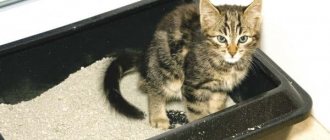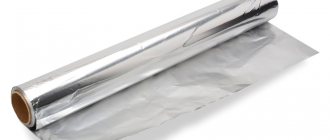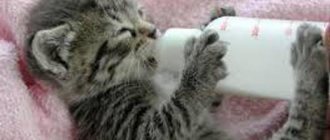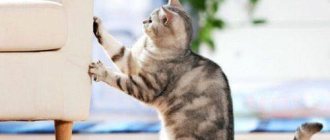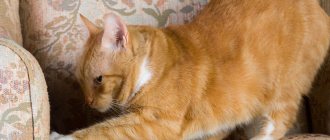In this article we will learn how to stop a cat from climbing on tables, and we will understand why our pets do this. A cat sitting on your work desk may not bother you, but seeing a pet next to a plate on the dining table will not be very pleasant. We advise you to immediately respond to such behavior and take action. The editors of Petstory examine a popular question among our readers: how to wean a cat from jumping on the table.
Why do cats tend to jump on the table?
First, let's look at the motives of behavior. They will help you better understand how to wean your cat off the table.
- Curiosity. Cats love to explore the space around them, smell objects and even taste them. The table attracts cats with the smell of food. They are interested in eating from their owner's bowl. Natural dexterity makes this easy to do. The table can also serve as a convenient viewing point. In nature, predators from the cat family hunt from above and rest on high branches. This instinct was passed on to domestic cats. The cat climbs onto the table to keep an eye on you and other animals and react in time if something interesting happens.
- Warm. If there are central heating radiators under the table, they can attract the cat in winter. It is convenient for the cat to lie on the table and warm up.
- Hunting instinct. Perhaps the table is the only place where the cat can look out the window. Then she will conduct bird watching from there. Also, a cat can climb onto the table in pursuit of a sunbeam or an insect.
- Safety. It is possible that the table is one of the few places where the cat can be alone, for example, if there is a puppy or small child in the house.
- Playfulness. A cat may show interest in the table due to lack of entertainment. If she doesn't have toys, she can climb on the table to throw small objects off.
Next, we’ll learn how to wean a cat off the table.
Method 3. Rearrange the furniture
If the cause of the chaos is the cat’s inability to get to the right place by other means, then it would be more logical to clear the way for him. Most often, due to the natural characteristics of the cat family, cats need to monitor the situation on the street from the window . Therefore, if there is a table on the way to it, the cat can climb on it.
A table by the window will attract a cat like a magnet, because there are so many interesting things happening outside the window.
How to stop a cat from climbing on tables?
The main task is to create unpleasant associations when the cat climbs on the table. Then interest in the tables will disappear.
Loud sounds
Place empty tin cans in the center of the table so that your pet cannot see them from below. After the next jump on the table, the cans will begin to fall and rattle, this will frighten the animal and may discourage it from jumping onto the table again.
Foil
Place sheets of foil along the edges of the table. When your pet jumps on the table, they will fall to the floor, making a very unpleasant metallic rustling sound.
Water
Take advantage of your pet's natural dislike of water. Place a large baking tray with water on the table. Having jumped onto the table, the animal will wet its paws, and after several such attempts it will completely lose the desire to climb on it. You can also use heating pads with water. Place some heating pads on the table. The gurgling sound under the paws will scare the pet. Pet stores sell a spray device that is equipped with a motion sensor. It will splash water on your pet every time he jumps on the table. The sensor detects movement at a distance of up to 1 meter. Don't forget to turn it off when you use the table yourself. You can spray the animal yourself, but do it carefully so that the cat does not see you. Otherwise he will start avoiding you.
Heavy objects
Place several heavy objects on the table in a chaotic manner. Take up all the space. Your pet will not be able to move them, and interest will disappear. In addition, on a surface filled with objects, it is more difficult to move and maintain balance.
Bright smells
Rub the table with lemon or other citrus fruits. The smell is too strong; it will scare the animal away from the table. The smell of vinegar will also be unpleasant for your pet. Rub the table with vinegar solution or pour it into a saucer. You can leave peeled garlic and onions on the table. There are also more pleasant ways for you. A bouquet of flowers with a strong aroma will scare away your pet.
Masking tape
Cut the tape into squares and place them across the table, sticky side up. Your pet's paws will start to stick to the tape, and he will not like it; he will perceive the table as a dirty space.
Own house
If the table is the only safety zone for your pet, then create comfortable conditions for him in another place. Buy a house with high, stable support, where the pet cannot be reached by small children or dogs.
Rearrangement of furniture
Perhaps there is a route across the table to your pet’s favorite place. Then a little rearrangement will help you. Create new conditions for the animal's movement.
Method 6. Pay attention to education in childhood
Education from early childhood . Kids quickly get used to everything new and learn. Any attempt to jump on the table must be stopped. Usually it is enough to knock loudly on the table on which the attack is being made. If you see that the kitten is getting ready to jump (before the jump, cats gather into a spring and try on), you can pick it up and move it to another room. If you have already jumped, knock on the table and remove the cat.
How to stop a kitten from climbing on a table?
The methods considered help correct the behavior of adult animals. Let's find out how to stop a kitten from climbing on a table.
Negative behavior appears at a very early age, but may seem like a cute prank. For example, many cats love to drink water from the tap. This causes affection for the owners, and they allow the pet to drink from the tap in the kitchen. Because of this, the cat perceives the kitchen as a space that can be explored. Therefore, allow him to drink only in the bathroom.
The kitten still doesn’t quite understand where his territory is and where yours is. He may associate you with the mother cat and look for food where you eat. Each time, patiently carry your little pet to his food bowl. This will help stop the kitten from jumping on the table. Your pet must understand that he can only eat from his own dishes. Teach your kitten to feed on time, combine your meals. Do not pick up your baby while you are sitting at the table and eating.
Kittens are more curious and playful than adult cats. They are just learning about the world, and everything is interesting to them. Use toys of different shapes and sizes that make rustling, rattling sounds to play with kittens. Perhaps the kitten has already studied the old toys and they are no longer interesting to him. Buy new ones or make them yourself.
Don't put off parenting until later. It’s easier to wean a kitten off the table. By the time they grow up, cats develop persistent patterns of behavior that they will follow in the future. Cats perfectly understand the intonations of their owner and will know how to act at a certain sound of your voice.
Method 4: Use a spray bottle of water, but with caution
Suitable for animals that do not really like water, but are not afraid of it either. Otherwise:
- may be perceived as a game if the cat really likes to swim;
- It may be difficult to wash the animal in the future if the cat gets very stressed.
The method consists of spraying the animal with a spray bottle when it tries to jump onto the table or when it is in the wrong place.
What we don't recommend doing
When choosing a training method, consider the character of your cat and choose gentle options. Some animals may be afraid of loud noises, so do not stress your pet.
Refuse violent parenting methods. They will not bring the desired effect, but will only worsen the relationship between you and the cat. We do not recommend using electric mats if your cat has climbed onto the table. This is too traumatic a method that will harm the health of your pet.
Screaming won't help either. The pet will only understand that in the presence of the owner it is forbidden to jump on the table, and will do this when you are not at home. In addition, the cat may not understand what caused your aggression, but will begin to be afraid of you. They will associate the feeling of fear with you rather than the table, and this will cause more serious behavioral problems. The table must cease to be a subject of games and pleasure for the cat, then he will lose interest in it.
To stop your cat from climbing on the table, we recommended using masking tape. Do not use other very sticky materials. They can stick to the cat's fur, and then you will have to cut it. The pet will also experience stress.
Weaning a cat or cat from walking on the table is not all. Understand the reasons for the behavior and offer the animal alternatives.
Hurry up, choose a box and find out what gift awaits you
Discount on pet insurance
Promo code copied to clipboard
Video: raising a cat correctly
Practice shows that the method using citrus essential oils is practically fail-safe. It effectively solves the problem of a cat climbing on tables in your absence and fills your home with a pleasant and refreshing aroma, which, by the way, also has a positive effect on your health, having immunostimulating and antiseptic properties. The main thing is that until the cat learns to walk where it is not supposed to, do not forget to treat the necessary surfaces before leaving the room. As with any treatment, the main thing here is systematicity.
Unexpected fall
The method is somewhat inhumane, but one session may be enough for the cat to forget the way to the table. To carry out the plan, you will need a lightweight plastic tray.
The tabletop is furnished with “inconvenient” objects so that only one side remains free. Bottles and pots will come in handy as an impromptu fence. Place the tray on the free side, pushing it slightly beyond the edge of the tabletop. You can pour some water into the tray itself.
Further events can be predicted. The cat doesn't want to jump on the tray, but there is no choice, because the whole table is occupied. The animal jumps, knocking over the tray. Water pours onto the cat, and the container itself falls to the floor with a crash.
After such a procedure, the pet will not dare to explore the table for a long time. For greater effect, the grief tray can be left in sight for several days.
Method 8: Use double-sided tape, but only under supervision
For these purposes, you can choose regular office double-sided tape, but there is a better option. There are special double-sided adhesive tapes that protect against cats. For example, Sticky Paws.
They work like this: when the cat decides to jump on the table, its paws will stick, and these sensations are very unpleasant for cats . As a result, the fluffy one will jump off and try not to repeat the mistakes again.
This method is not suitable for long-haired cats , because... the glued wool will have to be cut off. The cat may also get scared and begin to behave unpredictably. This risks the fact that he may become entangled in the tape or eat it while trying to free himself. Therefore, this method is only good under human supervision.
Method 9. Use foil, but very carefully
After the furry lawless creature tries to jump on the table, his paws will begin to slip, and the foil will rustle disgustingly. Cats don't like .
To prevent traumatic situations, this method is carried out only under human supervision . Having slipped, the cat may fall unsuccessfully, may begin to show interest in the foil and try to eat it. If you notice that the animal is playing with the foil, it is better to remove it altogether and use another method.
Folk remedies
The most popular folk remedy is vinegar. It is diluted in a 1:1 ratio and the area where the animal shits is washed. It not only removes unpleasant odors, but also repels the pet. Some people prefer to use bleach or bleach. But, firstly, not all mustaches are repelled by this smell. Secondly, for people living in an apartment, frequent use of bleach is unlikely to be beneficial, especially for children.
A weak solution of potassium permanganate, iodine solution (a few drops per liter of water), and hydrogen peroxide are suitable for disinfection. A paste of baking soda and water removes odor well, and after drying it can be easily swept up or removed with a vacuum cleaner.
Method 10. Set up a room or kitchen with climbing areas
Climbing to high places is one of the cat's instincts . If it is not possible to climb on them, a table is used. That is why, to satisfy the need for climbing, it is worth purchasing various vertical houses and scratching posts or equipping a play area for the cat yourself (all sorts of ropes, beds, pipes, and so on). With this alternative, the cat can easily forget the way to the kitchen table, which means our mission is completed.




